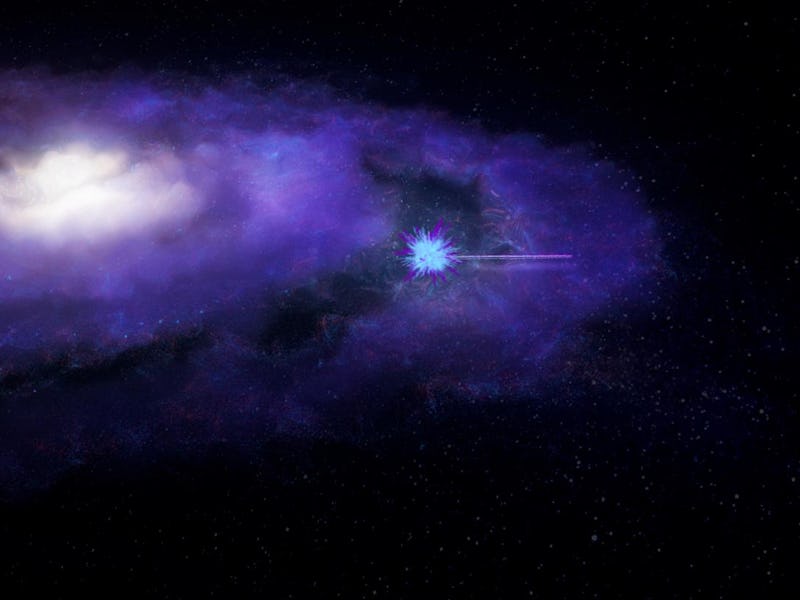Scientists solve the mysterious case of the universe's missing matter
A new study used fast radio bursts to detect missing matter.

When observing the vast universe, astronomers have long faced a frustrating problem. Half the amount of matter that showed up in theoretical models was missing, and it became known as the 'missing baryon problem.'
The problem loomed over our theories of the universe, either they were wrong or this baryonic matter was excellent at hiding. However, a team of scientists believe they have found the missing matter using fast radio bursts from distant galaxies.
A study, published Wednesday in the journal Nature, relies on mysterious blasts of radio wave radiation to resolve this decades old cosmic mystery.
What is the 'missing baryon' problem? After analyzing what is known as the 'cosmic microwave background,' or the amount of radiation leftover after the Big Bang, astronomers estimated that normal or baryonic matter, protons and neutrons that make up cosmic bodies like stars, planets and us, accounts for 4.85% of all contents of the universe. Baryonic matter is different from the even more elusive dark matter, which makes up more than 80% of the universe but has remained undetected.
However, when observing the Milky Way and other galaxies surrounding it, astronomers have found less than half the expected amount.
“We know from measurements of the Big Bang how much matter there was in the beginning of the universe but when we looked out into the present universe, we couldn’t find half of what should be there,"Jean-Pierre Macquart, associate professor at Curtin University node of the International Centre for Radio Astronomy Research, and lead author of the new study, said in a statement. "It was a bit of an embarrassment.”
The missing baryon problem has remained one of the most crucial missing pieces of the puzzle regarding scientists' models of the early universe, and how galaxies formed.
Scientists spent a fair amount of time in the past 20 years or so searching for this missing matter, but finding it is a bit of a challenge considering that the matter does not emit any light and the universe is extremely sparse. “The missing matter was equivalent to only one or two atoms in a room the size of an average office," Macquart said.
In order to locate this missing matter, the team of researchers behind the new study turned to another cosmic mystery; fast radio bursts.
Telescopes are on the hunt detecting fast radio bursts as they light up in the cosmos.
Fast radio bursts are bursts of intense radio signals that last for milliseconds, releasing energy that is equivalent to that released by the Sun in around 80 years. However, since their discovery in 2017, astronomers are still not sure where they originate from.
But that didn't matter for the new study, instead the team of scientists used fast radio bursts as 'cosmic weight stations.'
Using the Commonwealth Scientific and Industrial Research Organization's Australian Square Kilometer Array Pathfinder (ASKAP) radio telescope, they detected the fast radio bursts and measured their location to their host galaxies. Thereby, they were able to determine the location of the fast radio burst to the width of a human hair held 200m away, according to the researchers.
“The radiation from fast radio bursts gets spread out by the missing matter in the same way that you see the colors of sunlight being separated in a prism,” Macquart said.
Fast radio bursts spread out when they encounter the missing matter.
Therefore, the team also determined the relationship between how far away a fast radio burst is and how the burst spreads out as it travels through the universe. As a result, they calculated approximately how many electrons the radiation would have to encounter as it slowed down the fast radio burst.
However, the study points out that while the researchers are now aware that the missing matter exists out there, the next step would be to determine exactly where 'there' is.
Abstract: More than three-quarters of the baryonic content of the Universe resides in a highly difuse state that is difcult to detect, with only a small fraction directly observed in galaxies and galaxy clusters1,2 . Censuses of the nearby Universe have used absorption line spectroscopy3,4 to observe the ‘invisible’ baryons, but these measurements rely on large and uncertain corrections and are insensitive to most of the Universe’s volume and probably most of its mass. In particular, quasar spectroscopy is sensitive either to the very small amounts of hydrogen that exist in the atomic state, or to highly ionized and enriched gas4–6 in denser regions near galaxies7 . Other techniques to observe these invisible baryons also have limitations; Sunyaev–Zel’dovich analyses8,9 can provide evidence from gas within flamentary structures, and studies of X-ray emission are most sensitive to gas near galaxy clusters9,10. Here we report a measurement of the baryon content of the Universe using the dispersion of a sample of localized fast radio bursts; this technique determines the electron column density along each line of sight and accounts for every ionized baryon11–13. We augment the sample of reported arcsecond-localized14–18 fast radio bursts with four new localizations in host galaxies that have measured redshifts of 0.291, 0.118, 0.378 and 0.522. This completes a sample sufciently large to account for dispersion variations along the lines of sight and in the host-galaxy environments11, and we derive a cosmic baryon density of Ωb = 0.051−0.025h +0.021 70 −1 (95 per cent confdence; h70 = H0/(70 km s−1 Mpc−1) and H0 is Hubble’s constant). This independent measurement is consistent with values derived from the cosmic microwave background and from Big Bang nucleosynthesis1
This article was originally published on